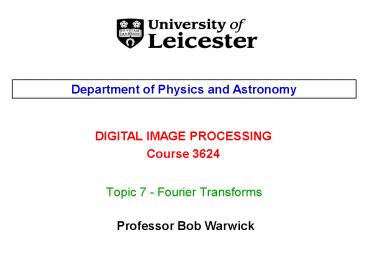Topic 7 - Fourier Transforms - PowerPoint PPT Presentation
1 / 24
Title:
Topic 7 - Fourier Transforms
Description:
Department of Physics and Astronomy DIGITAL IMAGE PROCESSING Course 3624 Topic 7 - Fourier Transforms Professor Bob Warwick 7.1 Review of The Fourier Transform ... – PowerPoint PPT presentation
Number of Views:248
Avg rating:3.0/5.0
Title: Topic 7 - Fourier Transforms
1
Topic 7 - Fourier Transforms
Department of Physics and Astronomy
DIGITAL IMAGE PROCESSING Course 3624
Professor Bob Warwick
2
7.1 Review of The Fourier Transform
- Many DIP techniques rely on the application of an
image transform of which the Fourier Transform
is the most popular. - The Fourier domain provides very important
insight into the information content of the data.
Outline of this Topic 7.1 Introduction to the
Fourier Transform (FT) 7.2 The Discrete Fourier
Transform (DFT) 7.3 The Properties of the
DFT 7.4 Computation of the DFT (via the FFT)
3
Spatial Frequency
The spatial frequency of this signal would be
with units of either cycles per m (physical
space) cycles per pixel (image space)
4
Fourier Transform of a Rectangular Function
5
Fourier Transform of a Gaussian
- Notes
- The Inverse Relationship narrow function in the
spatial domain results in a wide function in the
Fourier Domain. - In this case F(u) is not complex ie
6
The Impulse or Delta Function
7
A Table of FT Pairs
RECTANGULAR FUNCTION GAUSSIAN FUNCTION DELTA
FUNCTION COSINE FUNCTION SINE FUNCTION SHAH
FUNCTION
8
The 2-D Fourier Transform
9
More on Convolution Integrals
10
7.2 The Discrete Fourier Transform (DFT)
Consider a 1-d sampled dataset of dimension N
We need to evaluate F(u) on a grid of N points
(in u space). A good choice for the spacing is
?u1/X (1 cycle across the full extent of the
image)
11
The DFT continued
Finally we set , we
redistribute the normalization term and drop the
dashes
EXAMPLE Determine the DFT of a 4-point dataset
with input values f0 1 f1 1
f2 0 f3 0
Why the periodicity?
12
7.3 Some Properties of the DFT
(a) SAMPLING THEORY
Assume F(u) is zero outside range
-wltultw S(u) is a Shah Function with spacing
?u1/?x In the Fourier domain we have the
convolution S(u)F(u)
Input data stream (continuous variables) Repre
sent sampling by a comb of delta functions s(x)
a Shah Function The sampled version of f(x)
can be represented by s(x)f(x)
This explains the periodic nature of the DFT ie
it repeats at a rate (in u) of 1/?x
13
Some Properties of the DFT cont.
- SHANNONS SAMPLING THEOREM
- To avoid information loss it is necessary to
sample a signal at a rate equivalent to at least
twice the maximum frequency component present in
the signal. - That is we need w lt 1/2?x, where 1/2?x is known
as the Nyquist frequency.
14
Some Properties of the DFT cont.
(c) CHARACTER OF THE DFT Example 1-d 8-point
transform.
Fu
??
N8
N8
15
The Optical Transform
16
7.4 Computation of the DFT
In DIP applications we need to compute the 2-d
DFT
Hence, the 2-d DFT reduces to the computation of
a series of 1-d transforms.
In total we require 2N 1-d transforms, each of
which involves N x N complex multiplies and adds
ie N4 ? 2N3 calculations
17
The FFT Algorithm
18
Implementation of the FFT Algorithm
19
A Fortran FFT Routine
Re-ordering
Successive doubling
20
Calculating the Inverse Fourier Transform
If we take the complex conjugate of the inverse
transform and scale by 1/N
- To calculate the Inverse Transform with a
software procedure that computes the 1-d
forward transform - Convert Fu ? Fu
- (ii) Apply the forward transform
- (iii) Scale the result by N
- (iv) Convert fx ? fx
21
Example of a 2-d DFT calculation
fxy
(-1)xy
Fuv
log Fuv
22
And the Inverse .
(-1)xy
Ignoring the amplitude!
Ignoring the phase!
23
Example of a 2-d DFT
log Fuv
24
Magnitude-only Reconstruction
Phase-only Reconstruction































